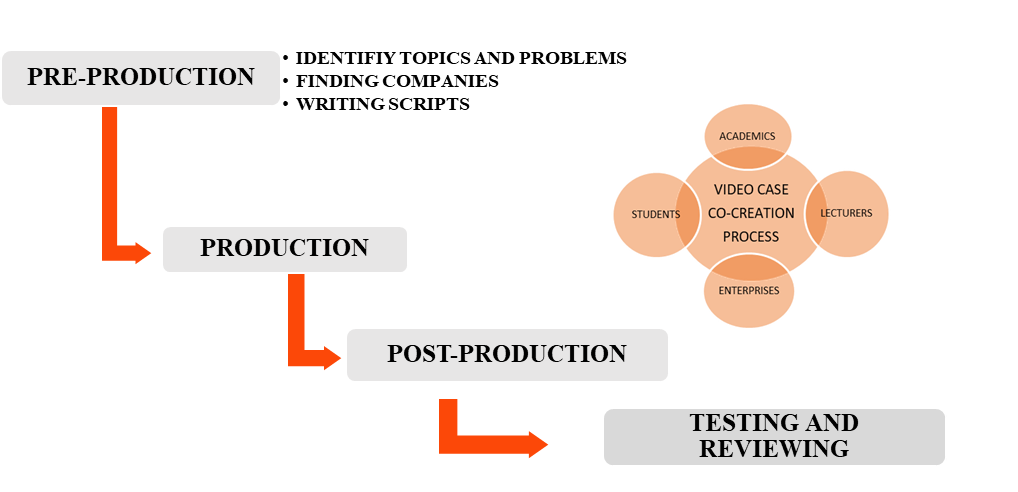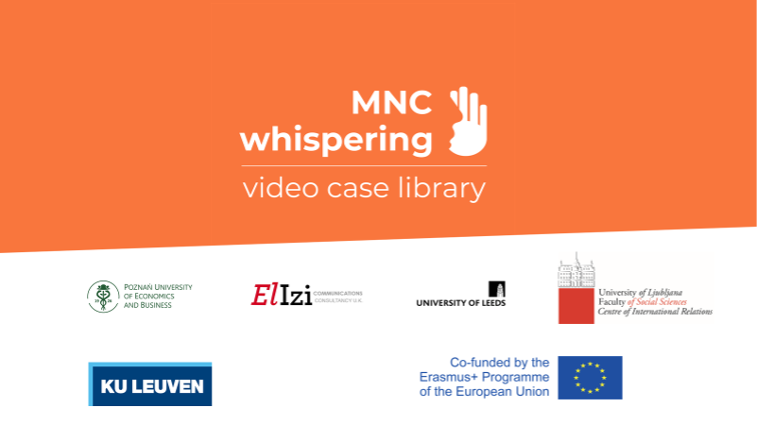In order to develop more engaging video cases for students, MNC Whispering has developed video cases that have been co-created by academics and businesses for teaching International Business (IB) based on the Brands Whisper’g® video case methodology.
The development of these video cases consists of the following steps:

Source: MNC Whispering and Brands Whisper’g®
Pre-production (preparation stage)
One of the first steps in the video case development is finding a real-life situation that a company has experienced, which could be used as an example while teaching.
The academic identifies and approaches a business with a theme for a video case study. In conversations with the company, the theme is verified, and detailed examples are collected. Through the conversations, the academic and the business agree on a narrative that introduces the business and industry, the challenge that is at the heart of the case, various scenarios the company considered, addressing the challenge (problem), and how the business ultimately decided (solution).
Next, a video case study needs a script, which is written on the basis of preliminary research of the company and interview with the manager. In video cases this is written like a film script, incorporating audio and video elements. In other words, the audio side sets out the story; while the video side provides the relevant visuals, animations, and illustrations that will be accompanying the audio. And while cases are written by the academic, they are narrated by the manager for authenticity and higher student attention and engagement.
While the video case can be between 20-30 minutes, it is best to split up the script into various sections, which will allow for classroom or group discussions in between the sections and also improve viewers’ attention as the maximum length of any section should not extend beyond 5-7 minutes. The length of the script also determines the length of the video. For instance, in English on average 125-150 words are spoken per minute; mainly depending on how fast the executive is talking.
It is recommended to record the video case in the executive’s mother tongue. In this case the narrative can be faded out and dubbed with an English voiceover while captions could be added. The dubbing process will also allow for any necessary amendments to be made in the original video recording.
Production (video shoot)
The production stage mainly consists of the video recording process. The video shoot can be done: 1) by a professional production crew or 2) by using the production teams and facilities found in universities or 3) by the academic if the academic feels confident to do so. Although it is important to use a good camera, it is also critical to use a professional clip-on microphone.
During the recording, it is suggested that the narrator is seated opposite the academic and together they engage in a conversation along the lines of the script. This helps the manager to talk while not looking directly at the camera. If managers use their own words instead of reading from a prompter, this will make them look as if they are talking naturally and spontaneously. It could be necessary to do some retakes, to make sure that the content and the delivery of answers are adequate. Just before finishing off the video shoot, it is a good idea to stop for a few minutes and go over the script quickly to make sure that all points are covered.

Post-production (video editing)
After getting the video shoot’s transcript, the academic can edit it, using track changes, which is then shared with the post-production team for the actual editing. In addition, the video footage can be overlaid with complementary visuals following the script. Having these complementary stills and videos (also called B-roll), explaining what the audio says at that specific moment also improves the attention span of viewers. Similar to the production phase, post-production can be undertaken by a professional team or by the academic. The learning curve might be a bit steep for academics but once they start using the software, one can build on the experience easily.
Testing and reviewing
Before making the video case available, it is strongly recommended to test it with students to make sure that all elements in the video serve the intended purpose. Similarly, getting peer feedback from other educators and from businesses is one of the best methods for improving the video cases before finalizing them. Even then, this is an iterative process, and it can be further improved as video cases are used for teaching/training purposes in different learning ecosystems. This iterative process will also allow for the creation of useful written information for students and lecturers as teaching notes are obviously required to help lecturers to use the video case as intended, in various teaching formats.
Further information for the project can be found here https://www.mncwhispering.com/
Acknowledgments:
This article has been inspired and adapted from: De Beule, F., Jaklič, A., Vardar, N., & Voss, H. (2021) How to write and develop a video case? The case of co-created video cases, AOM Newsletter, International Management division, Teaching Resources.

Author
Dr. Filip De Beule is an Associate Professor of International Business at the Department of Management, Strategy and Innovation, Faculty of Economics and Business, KU Leuven, Belgium. His research focuses on various aspects of internationalization and international business.
Editor’s note: Filip De Beule is coordinator of the project; Video Case Library 4 Teaching IB (VCL4IB) aka MNC Whispering. The MNC Whispering project has received funding under the European Union’s Erasmus+ program (Open Access Digital Video Case Library for Teaching International Business: Project No.2018-1-BE02-KA203-046832). Further information about the project can be found here














